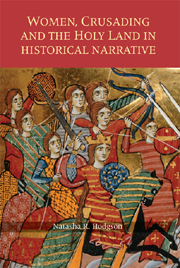Conclusion
Published online by Cambridge University Press: 12 September 2012
Summary
THE sources which record the history of crusading and the Latin East during the twelfth and thirteenth centuries were subject to a wide variety of literary influences, both ecclesiastical and lay, and their perceptions of women varied accordingly. Preachers and canonists may have attempted to prevent women from taking the cross, and many authors of narratives agreed to this principle, but there was inherent disparity within both the theory of women's involvement in crusading and the practical reality of their presence on crusade expeditions – their role in ‘historical’ events. Women were not the only group treated in this manner – many criticisms applied to a range of anonymous non-combatants, including the sick, the young and the elderly. Such restrictions were seldom extended to individual noblewomen who took the cross, as long as they adhered to correct modes of behaviour. They usually accompanied their male kin who would take part in the fighting, and if they could provide financial support to the crusade army, rather than draining its resources, they were often welcomed.
However, high death rates on crusade through warfare, famine or disease could lead to rapid changes in the social arrangements between crusaders, both men and women. Whether they took part in an expedition or not, noblewomen and their families were identified with the aristocratic audience at whom the crusade message was aimed, and authors seemingly found no inherent contradiction in portraying women as a gender to be ‘inhibitors’, but recognising certain women to be ‘enablers’.
- Type
- Chapter
- Information
- Women, Crusading and the Holy Land in Historical Narrative , pp. 236 - 245Publisher: Boydell & BrewerPrint publication year: 2007



